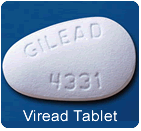| Tenofovir
(Viread) Produces Continued HBV Suppression through 96 Weeks in HBeAg Positive
and Negative Patients: Studies 102 and 103 By
Liz Highleyman
 Several
antiviral agents have potent activity against hepatitis
B virus (HBV), but the emergence of drug-resistance mutations is a barrier
to long-term treatment effectiveness. Several
antiviral agents have potent activity against hepatitis
B virus (HBV), but the emergence of drug-resistance mutations is a barrier
to long-term treatment effectiveness.
At the 59th
Annual Meeting of the American Association for the Study of Liver Diseases (AASLD
2008) this week in San Francisco, researchers presented 96-week results from
2 Gilead clinical trials assessing tenofovir
(Viread) in patients with hepatitis B "e" antigen (HBeAg) negative
and HBeAg positive chronic hepatitis B.
Tenofovir is widely used to treat
HIV, and was approved
in August as a therapy for chronic hepatitis B.
Studies 102 and 103
were multicenter, randomized, double-blind Phase 3 trials comparing tenofovir
versus adefovir (Hepsera) in chronic
hepatitis B patients with compensated liver disease. Study 102 included 375 HBeAg
negative patients, while Study 103 included 266 HBeAg positive participants. About
68% were men and the mean age was 43 years. In Study 102 about two-thirds were
Caucasian and one-quarter were Asian; in Study 103, about half were Caucasian,
and about one-third were Asian. Most were treatment-naive, though about 15% had
previously used lamivudine (Epivir-HBV).
The studies did not include patients with HIV-HBV
coinfection.
As
previously reported, tenofovir produced higher rates of HBV DNA clearance
< 400 copies/mL compared with adefovir at 48 weeks (93% vs 63% in Study 102;
76% vs 13% in Study 203..
After the initial 48-week treatment period, patients
originally randomized to receive adefovir in both studies switched to open-label
tenofovir for another 48 weeks, while those originally assigned to tenofovir continued
to take it for the same duration.
After 72 weeks, patients with continued
HBV DNA > 400 copies/mL (confirmed on 2 consecutive visits) had the
option of adding emtricitabine (Emtriva,
also combined with tenofovir in
the Truvada fixed-dose coformulation). Emtricitabine is approved for treatment
of HIV and is under study for hepatitis B.
96-week data from both studies
was presented at the Liver Meeting. The study is scheduled to continue through
384 weeks (more than 7 years).
Combined
Results:
•
Patients who received tenofovir for up
to 96 weeks experienced sustained HBV DNA suppression.
•
All patients who had undetectable HBV
DNA while on adefovir maintained virological suppression after switching to tenofovir
at week 48.
•
Patients generally had achieved ALT normalization
by week 48, and this was maintained through week 96.
•
Tenofovir continued to be well-tolerated,
and no new safety issues were identified.
•
No mutations associated with tenofovir
resistance were identified in either study.
Study
102 Results
•
In an intent-to-treat analysis at 96 weeks,
91% of HBeAg negative patients originally randomized to the tenofovir arm and
89% of those who switched from adefovir to tenofovir achieved sustained HBV DNA
suppression < 400 copies/mL.
•
In an as treated analysis, 96% of patients
in the continuous tenofovir arm and all patients in the switch arm achieved undetectable
HBV DNA.
•
Of the 2 patients who added emtricitabine
after 72 weeks, 1 achieved full virological suppression by week 96.
•
None of the patients experienced hepatitis
B surface antigen (HBsAg) loss.
•
10% of patients in both the continuous
tenofovir arm and the adefovir-to-tenofovir switch arm had grade 3-4 laboratory
abnormalities.
•
No patients experienced a confirmed 0.5
mg/dL increase in serum creatinine or creatinine clearance less than 50 ml/min
(markers of kidney damage, a potential side effect of adefovir and tenofovir in
susceptible patients).
The investigators concluded that tenofovir "produced
potent, continuous viral suppression and was well tolerated through week 96."
"Patients
switching to tenofovir after 48 weeks of adefovir treatment benefited with significant
additional viral suppression and had a similar response to patients treated with
tenofovir for 96 weeks," they added.
"In this study, Viread [tenofovir]
produced a significant and sustained effect over two years of treatment with no
evidence of resistance, which is a substantial clinical finding," said principle
investigator Patrick Marcellin, MD, in a press release issued by Gilead. "Additionally,
patients in this study taking Hepsera [adefovir] were rolled over to Viread without
new safety signals and without compromising the efficacy of anti-HBV treatment."
Hopital
Beaujon, University of Paris, Clichy, France; Hospital Valle Hebron, Barcelona,
Spain; University Hospital St Ivan Rilsky, Sofia, Bulgaria; University of Uludag,
Bursa, Turkey; Tokuda Hospital, Sofia, Bulgaria; Royal Free Hospital, London,
UK; University of Calgary, Calgary, Alberta, Canada; Toronto Western Hospital,
University of Toronto, Toronto, Ontario, Canada; Gilead Sciences, Durham, NC.
Study
103 Results
•
In a 96-week intent-to-treat analysis,
78% of HBeAg positive patients achieved HBV DNA suppression < 400 copies/mL
in both the continuous tenofovir arm and the adefovir-to-tenofovir switch arm.
•
In an as-treated analysis, 89% and 85%,
respectively, had undetectable HBV DNA at 96 weeks.
•
82% of patients with detectable viremia
at week 48 on adefovir experienced full viral suppression at 96 weeks after switching
to tenofovir.
•
28 patients added emtricitabine after
72 weeks due to continued viremia, 5 of whom achieved viral suppression by week
96.
•
30% of patients in the continuous tenofovir
arm and 28% in the switch arm experienced HBeAg loss, while 26% and 24%, respectively,
experienced HBeAg seroconversion (appearance of anti-HBe antibodies).
•
6% of patients in both groups experienced
HBsAg loss; 4% who received continuous tenofovir and 5% who switched experienced
HBsAg seroconversion (considered an indicator of resolved infection).
•
7% of patients in the continuous tenofovir
arm and 10% in the switch arm experienced grade 3-4 laboratory abnormalities.
•
No patients experienced creatinine clearance
less than 50 ml/min, but 2 in the adefovir-to-tenofovir switch arm had a confirmed
0.5 mg/dL increase in serum creatinine.
As
with Study 102, the investigators concluded that tenofovir produced potent, continuous
viral suppression and was well tolerated through week 96 in HBeAg positive patients,
and that switching from adefovir to tenofovir led to significant additional viral
suppression.
Toronto Western Hospital, University of Toronto, Toronto,
Ontario, Canada; Middlemore Hospital, Auckland, New Zealand; Erasmus MC, University
Medical Center Rotterdam, Rotterdam, Netherlands; Dreamwork Medical Group, Flushing,
NY; Monash University, Melbourne, Victoria, Australia; Center for HIV and Gastroenterology,
Dusseldorf, Germany; Hopital Beaujon, University of Paris, Clichy, France; Gilead
Sciences, Durham, NC.
11/07/08 References P
Marcellin, M Buti, Z Krastev, and others. Two Year Tenofovir Disoproxil Fumarate
(TDF) Treatment and Adefovir Dipivoxil (ADV) Switch Data in HBeAg-Negative Patients
with Chronic Hepatitis B (Study 102), Preliminary Analysis. 59th Annual Meeting
of the American Association for the Study of Liver Diseases (AASLD 2008). San
Francisco. October 31-November 4, 2008. Abstract 146.
E Heathcote, EJ Gane,
RA deMan, and others. Two Year Tenofovir Disoproxil Fumarate (TDF) Treatment and
Adefovir Dipivoxil (ADV) Switch Data in HBeAg-Positive Patients With Chronic Hepatitis
B (Study 103), Preliminary Analysis. 59th Annual Meeting of the American Association
for the Study of Liver Diseases (AASLD 2008). San Francisco. October 31-November
4, 2008. Abstract 158.
Other source
Gilead Sciences. Gilead Announces
Two-Year Data from Pivotal Phase III Studies Evaluating Viread(R) for Chronic
Hepatitis B. Press release. November 1, 2008. |

![]()
 Several
antiviral agents have potent activity against
Several
antiviral agents have potent activity against